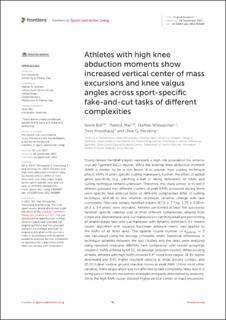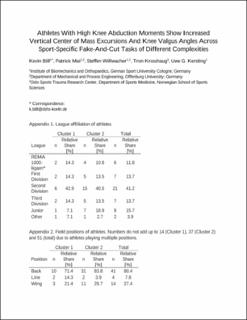| dc.contributor.author | Bill, Kevin | |
| dc.contributor.author | Mai, Patrick | |
| dc.contributor.author | Willwacher, Steffen | |
| dc.contributor.author | Krosshaug, Tron | |
| dc.contributor.author | Kersting, Uwe G. | |
| dc.date.accessioned | 2022-12-01T09:51:57Z | |
| dc.date.available | 2022-12-01T09:51:57Z | |
| dc.date.created | 2022-10-18T15:58:00Z | |
| dc.date.issued | 2022 | |
| dc.identifier.citation | Frontiers in Sports and Active Living. 2022, 4, Artikkel 983889. | en_US |
| dc.identifier.issn | 2624-9367 | |
| dc.identifier.uri | https://hdl.handle.net/11250/3035248 | |
| dc.description | This is an open-access article distributed under the terms of the Creative Commons Attribution License (CC BY). The use, distribution or reproduction in other forums is permitted, provided the original author(s) and the copyright owner(s) are credited and that the original publication in this journal is cited, in accordance with accepted academic practice. No use, distribution or reproduction is permitted which does not comply with these terms. | en_US |
| dc.description.abstract | Young female handball players represent a high-risk population for anterior cruciate ligament (ACL) injuries. While the external knee abduction moment (KAM) is known to be a risk factor, it is unclear how cutting technique affects KAMs in sport-specific cutting maneuvers. Further, the effect of added game specificity (e.g., catching a ball or faking defenders) on KAMs and cutting technique remains unknown. Therefore, this study aimed: (i) to test if athletes grouped into different clusters of peak KAMs produced during three sport-specific fake-and-cut tasks of different complexities differ in cutting technique, and (ii) to test whether technique variables change with task complexity. Fifty-one female handball players (67.0 ± 7.7 kg, 1.70 ± 0.06 m, 19.2 ± 3.4 years) were recruited. Athletes performed at least five successful handball-specific sidestep cuts of three different complexities ranging from simple pre-planned fake-and-cut maneuvers to catching a ball and performing an unanticipated fake-and-cut maneuver with dynamic defenders. A k-means cluster algorithm with squared Euclidean distance metric was applied to the KAMs of all three tasks. The optimal cluster number of koptimal = 2 was calculated using the average silhouette width. Statistical differences in technique variables between the two clusters and the tasks were analyzed using repeated-measures ANOVAs (task complexity) with nested groupings (clusters). KAMs differed by 64.5%, on average, between clusters. When pooling all tasks, athletes with high KAMs showed 3.4° more knee valgus, 16.9% higher downward and 8.4% higher resultant velocity at initial ground contact, and 20.5% higher vertical ground reaction forces at peak KAM. Unlike most other variables, knee valgus angle was not affected by task complexity, likely due to it being part of inherent movement strategies and partly determined by anatomy. Since the high KAM cluster showed higher vertical center of mass excursions and knee valgus angles in all tasks, it is likely that this is part of an automated motor program developed over the players' careers. Based on these results, reducing knee valgus and downward velocity bears the potential to mitigate knee joint loading and therefore ACL injury risk. | en_US |
| dc.language.iso | eng | en_US |
| dc.subject | anterior cruciate ligament | en_US |
| dc.subject | biomechanics | en_US |
| dc.subject | change of direction | en_US |
| dc.subject | cutting | en_US |
| dc.subject | injury prevention | en_US |
| dc.subject | knee loading | en_US |
| dc.subject | screening | en_US |
| dc.subject | unanticipated | en_US |
| dc.title | Athletes with high knee abduction moments show increased vertical center of mass excursions and knee valgus angles across sport-specific fake-and-cut tasks of different complexities | en_US |
| dc.type | Peer reviewed | en_US |
| dc.type | Journal article | en_US |
| dc.description.version | publishedVersion | en_US |
| dc.rights.holder | © 2022 Bill, Mai, Willwacher, Krosshaug and Kersting | en_US |
| dc.source.pagenumber | 13 | en_US |
| dc.source.volume | 4 | en_US |
| dc.source.journal | Frontiers in Sports and Active Living | en_US |
| dc.identifier.doi | 10.3389/fspor.2022.983889 | |
| dc.identifier.cristin | 2062488 | |
| dc.description.localcode | Institutt for idrettsmedisinske fag / Department of Sports Medicine | en_US |
| dc.source.articlenumber | 983889 | en_US |
| cristin.ispublished | true | |
| cristin.fulltext | original | |
| cristin.qualitycode | 1 | |

